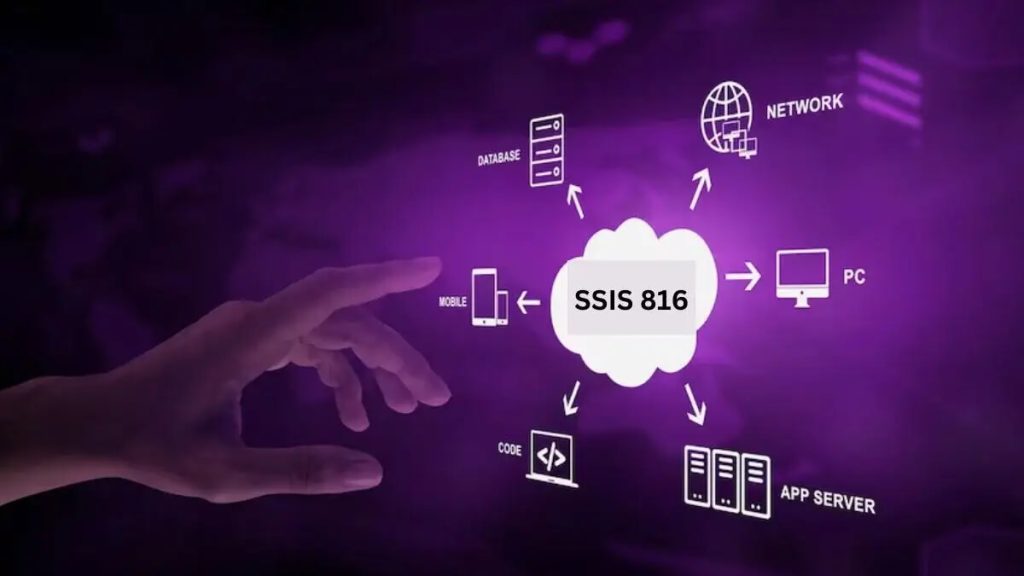SSIS 816: Staying abreast of the latest technologies and tools is imperative for data professionals. Among these tools, SQL Server Integration Services (SSIS) stands out as Microsoft’s flagship solution for enterprise data integration, transformation, and migration. The release of SQL Server Integration Services 2016 (SSIS 2016) brought significant advancements in scalability, performance, and usability, setting a new standard for data integration. Building upon the foundation laid by its predecessor, SSIS 2019 introduces even more enhancements and capabilities, empowering data professionals to tackle complex data challenges with confidence.
What Is SSIS 816?
SSIS 816 refers to the latest iteration of SQL Server Integration Services, version 2019. It represents a culmination of Microsoft’s efforts to refine and enhance the data integration experience for users across diverse industries. SSIS 816 incorporates a plethora of features designed to streamline workflows, improve performance, and facilitate seamless data integration processes.
How to Get Started With SSIS 816
Getting started with SSIS 816 is an exciting journey for data professionals looking to harness the full potential of this powerful tool. Here’s a step-by-step guide to kickstart your SSIS 816 journey:
- Installation and Setup: Begin by downloading and installing SQL Server Integration Services 2019 from the official Microsoft website. Ensure that your system meets the necessary prerequisites, including compatible hardware and software configurations.
- Exploring the Interface: Familiarize yourself with the SSIS 816 interface, which comprises various components such as the Solution Explorer, Toolbox, and Control Flow Designer. Understanding the layout and functionality of these elements is essential for efficient package development.
- Creating Your First Package: Dive into the world of SSIS by creating your first package. Start with simple tasks such as extracting data from a source, transforming it using built-in SSIS transformations, and loading it into a destination. Experiment with different data flow components to gain a deeper understanding of their capabilities.
- Utilizing SSIS Tools and Features: Explore the myriad of tools and features offered by SSIS 816, including data profiling, package deployment utilities, and integration with other Microsoft products such as Azure Data Factory. Leverage these tools to streamline your data integration workflows and maximize efficiency.
- Learning Resources and Community Support: Take advantage of online tutorials, documentation, and community forums to enhance your SSIS proficiency. Engage with fellow data professionals, exchange ideas, and seek guidance from experienced users to accelerate your learning curve.

Key Features and Capabilities of SSIS 816
SSIS 816 introduces a plethora of features and capabilities designed to empower data professionals and streamline data integration processes. Some of the key highlights include:
- Enhanced Scalability: SSIS 816 leverages modern infrastructure and parallel processing techniques to deliver unparalleled scalability, allowing users to handle large volumes of data with ease.
- Improved Performance: With optimized data processing algorithms and enhanced memory management, SSIS 816 delivers superior performance, enabling faster execution of data integration tasks.
- Advanced Data Transformations: Building on its predecessor’s capabilities, SSIS 816 offers a comprehensive suite of data transformation components, including advanced transformations for complex data manipulation tasks.
- Enhanced Connectivity: SSIS 816 provides seamless connectivity to a wide range of data sources and destinations, including on-premises databases, cloud platforms, and big data systems, ensuring compatibility with diverse environments.
- Enhanced Security: With robust encryption algorithms and enhanced security features, SSIS 816 ensures the confidentiality and integrity of sensitive data throughout the integration process.
- Intuitive Visual Interface: The intuitive visual interface of SSIS 816 simplifies the process of designing, deploying, and monitoring data integration packages, enabling users to create complex workflows with ease.
- Integration with Azure Services: SSIS 816 offers seamless integration with Microsoft Azure services, enabling users to leverage the scalability and flexibility of the cloud for data integration tasks.
Benefits of Upgrading to SSIS 816
Upgrading to SSIS 816 offers a myriad of benefits for organizations and data professionals alike. Some of the key advantages include:
- Increased Efficiency: SSIS 816 streamlines data integration workflows, reducing development time and effort required to create and maintain data integration processes.
- Enhanced Performance: By leveraging advanced processing techniques and optimization algorithms, SSIS 816 delivers superior performance, enabling faster execution of data integration tasks.
- Improved Scalability: With support for modern infrastructure and parallel processing, SSIS 816 scales effortlessly to handle growing volumes of data, ensuring optimal performance in diverse environments.
- Advanced Security: SSIS 816 incorporates robust encryption algorithms and enhanced security features, safeguarding sensitive data against unauthorized access and ensuring compliance with regulatory requirements.
- Seamless Integration: With support for a wide range of data sources and destinations, including cloud platforms and big data systems, SSIS 816 facilitates seamless integration across diverse environments, ensuring compatibility and interoperability.
- Cost Savings: By optimizing resource utilization and streamlining data integration processes, SSIS 816 helps organizations reduce operational costs and maximize return on investment in data management infrastructure.
Changes and Enhancements in SSIS 816
SSIS 816 introduces several changes and enhancements aimed at improving usability, performance, and scalability. Some of the notable changes include:
- Enhanced Data Flow Engine: SSIS 816 features an enhanced data flow engine that leverages parallel processing techniques to improve performance and scalability.
- Improved Monitoring and Logging: SSIS 816 offers enhanced monitoring and logging capabilities, allowing users to track the execution of data integration packages in real-time and troubleshoot issues more effectively.
- Integration with Power BI: SSIS 816 integrates seamlessly with Power BI, enabling users to visualize and analyze data from diverse sources with ease.
- Enhanced Data Cleansing Tools: SSIS 816 introduces advanced data cleansing tools, including fuzzy matching and data deduplication, to ensure the quality and accuracy of integrated data.
- Support for Azure Data Lake: SSIS 816 provides native support for Azure Data Lake, allowing users to seamlessly integrate data from on-premises and cloud-based sources for analytics and reporting.
Configure and Execute the Package
Configuring and executing SSIS packages is a straightforward process that can be accomplished using the SSIS 816 interface or command-line utilities. Here’s a brief overview of the steps involved:
- Configuration: Start by configuring your SSIS package using the SSIS 816 interface. Specify the connection strings, variables, and parameters required for the data integration process.
- Execution: Once the package is configured, you can execute it using the Execute Package Utility or programmatically using the SSIS object model. Monitor the execution progress and handle any errors or exceptions that may occur during the process.
- Logging and Monitoring: Enable logging and monitoring features to track the execution of the package and capture relevant information such as execution duration, row counts, and error messages. Use this data to troubleshoot issues and optimize performance.
- Deployment: After testing the package locally, deploy it to the production environment using the SSIS Deployment Wizard or other deployment utilities. Ensure that all dependencies are resolved and the package is configured correctly for the target environment.
- Scheduling: Schedule the execution of SSIS packages using SQL Server Agent or third-party scheduling tools to automate recurring data integration tasks. Configure alerts and notifications to stay informed about the status of package execution.
Conclusion
In conclusion, SSIS 816 represents a significant milestone in the evolution of Microsoft’s data integration platform, offering enhanced capabilities, performance, and scalability for data professionals. By upgrading to SSIS 816 and harnessing its advanced features, organizations can streamline their data integration processes, improve efficiency, and unlock new insights from their data assets. With its intuitive interface, seamless integration with Azure services, and robust security features, SSIS 816 is poised to revolutionize the way organizations manage and leverage data in today’s data-driven world. Embrace the power of SSIS 816 and embark on a journey towards mastering data integration in the modern era. Keep reading on Trendknowlege com.
FAQS
1. What is SSIS 816?
- SSIS 816 refers to the latest version of SQL Server Integration Services, released in 2019. It is a comprehensive data integration, transformation, and migration tool provided by Microsoft, designed to empower data professionals in managing complex data workflows efficiently.
2. What are the key features of SSIS 816?
- SSIS 816 introduces several key features, including enhanced scalability, improved performance, advanced data transformations, seamless integration with Azure services, enhanced security, and an intuitive visual interface. These features enable users to streamline data integration processes, enhance efficiency, and ensure the integrity of their data assets.
3. How do I get started with SSIS 816?
- To get started with SSIS 816, you can download and install the SQL Server Integration Services 2019 package from the official Microsoft website. Once installed, familiarize yourself with the interface, explore the available tools and features, and begin creating your first data integration package.
4. What are the benefits of upgrading to SSIS 816?
- Upgrading to SSIS 816 offers numerous benefits, including increased efficiency, enhanced performance, improved scalability, advanced security features, seamless integration with other Microsoft products such as Azure services, and cost savings through optimized resource utilization. These advantages enable organizations to streamline their data integration processes, improve decision-making, and drive business growth.
5. Can SSIS 816 integrate with other Microsoft products and services?
- Yes, SSIS 816 offers seamless integration with a wide range of Microsoft products and services, including Azure Data Factory, Power BI, Azure Data Lake, and SQL Server Analysis Services. This integration enables users to leverage the scalability, flexibility, and advanced analytics capabilities of these platforms to enhance their data integration workflows and gain valuable insights from their data.
6. How do I configure and execute SSIS packages in SSIS 816?
- Configuring and executing SSIS packages in SSIS 816 is a straightforward process. You can use the SSIS interface to configure package settings such as connection strings, variables, and parameters, and then execute the package using the Execute Package Utility or programmatically using the SSIS object model. Monitor the execution progress, handle any errors or exceptions, and deploy the package to production for scheduled execution as needed.
7. Is there community support available for SSIS 816 users?
- Yes, there is a vibrant community of SSIS users who actively engage in online forums, user groups, and community events to share knowledge, exchange ideas, and provide support to fellow users. Additionally, Microsoft offers extensive documentation, tutorials, and resources to help users learn and master SSIS 816 effectively.
8. How frequently are updates and enhancements released for SSIS 816?
- Microsoft regularly releases updates and enhancements for SSIS 816 to address bugs, introduce new features, and improve performance and security. Users can stay informed about these updates through official channels such as the Microsoft website, product documentation, and community forums, and ensure that they are always using the latest version of the software to maximize its capabilities.






